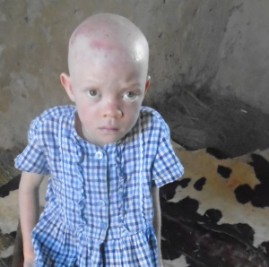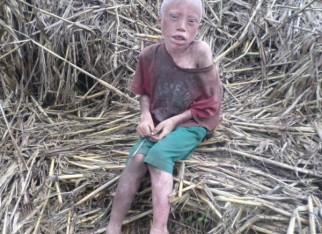The Rescue of Shanitah
by Michael Sabiiti
County Director, Humanity Healing International
Founder, SCOSP Uganda
Background
Since we began working with Humanity Healing International with the Albino Rescue Project, word of the program spread to the surrounding communities and I have been invited to speak on the radio, which has the spread the word throughout the region.
Whereas Uganda has made good progress as a developing country, there are still gaps and deficits that are unacceptable, such as these barbaric practices, the trafficking of children, ritual sacrifices etc.
I received a telephone call from a woman who said she knew of a little girl who was being held in a witch-doctor’s compound and was being used for blood-letting, an act of brutal black ritual sacrifice. After discussing the news with Christopher Buck, we were giving the green light for the mission to rescue Shanitah Akampurira, the albino girl being held in slavery.
The Rescue
With the backing of Humanity Healing, we had a joint effort between the staff at SCOSP, the old lady who let us know about the child (who asked her name not to be shared), and one police officer (Afande) who was informed about our mission so as to keep on alert in case of anything fishy or an attack on us. Our success with the Project has made some evil men angry at us.
The area where Shanitah was being held is very remote and the heavy rain made transportation very difficult. There was also an outbreak of a deadly disease called Marburg in western Uganda which kills like Ebola, which made us very nervous to make contact with others.
After two days of traveling to reach her, the old lady asked me to identify myself and was not convinced until I pulled out my iPad to show her the photos of the other successful rescue operations in the past.
At this point she was open to narrate the story of how she got in contact with Shanitah at the witchdoctor’s shrine. She is a traditional birth attendant and she knew of Shanitah for a long time because she was the one who helped her mother to deliver her at her traditional birth place, locally known as Izaariro. She told me that Shanitah ‘s parents separated soon after her birth and two years later, her mother took her to a place called Karungu to stay with her old granny who was suffering from diabetes (known as “Oburweire bwa Sukari). At this point I had not yet seen Shanitah and I became uncomfortable and felt that I was possibly being set up because she told us that she wanted only one person in her home and everyone else had to remain outside of her home.
When asked why she had decided to risk her own safety for the child, she said as a local birth attendant, she is endowed with a blessing to love all the children of any kind.
She had this to say, “I am a traditional birth attendant who does not like the practices of child sacrifice. I don’t facilitate the process of bringing children into the world and then at the same time support the ending their innocent lives – that would be playing double standards”





